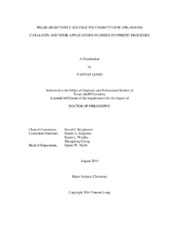| dc.contributor.advisor | Bergbreiter, David E | |
| dc.creator | Liang, Yannan | |
| dc.date.accessioned | 2020-02-27T17:28:55Z | |
| dc.date.available | 2020-02-27T17:28:55Z | |
| dc.date.created | 2016-08 | |
| dc.date.issued | 2016-05-19 | |
| dc.date.submitted | August 2016 | |
| dc.identifier.uri | https://hdl.handle.net/1969.1/187375 | |
| dc.description.abstract | The use of soluble polymer-supported catalysts in homogeneous catalysis has received heightened attention in the past few decades. Previous studies have shown that PIB oligomers have an excellent phase-selective solubility in nonpolar solvents, this property enables facile catalyst/product separation after reactions. This dissertation describes the study of using PIB as a tool in recovery and reuse of the photoredox catalysts and in the development of novel synthetic methods.
Heptane-soluble PIB-bound Ru(II)-bipyridine complexes [Ru(PIB-bpy)3Cl2] were prepared and used as photoredox catalysts in reactions including polymerization, oxidative C-C bond cleavage, and [2 + 2] cycloaddition. The results show that the catalyst can be successfully recovered and reused with leaching levels of ca. 1% of the charged catalyst. In addition, the synthesis of a recyclable PIB-bound 10- phenylphenothiazine (PIB-BTH) organic photoredox catalyst is described. This catalyst can efficiently carry out light-mediated radical polymerizations of methacrylates and can be separated from the polymer product via a simple separation process and reused with no significant loss of catalytic activity.
Cyclopropanation and O-H insertion reactions were carried out using a PIBbound Rh(II) complex. The results show that the phase-selective solubility of the PIBbound Rh(II) catalyst in a biphasic heptane/acetonitrile mixture can be used not only to recycle the catalyst but also to suppress the side reactions without the use of conventional slow addition method. These studies also suggest that hydrocarbon polymer cosolvents can function as antileaching agents that decrease the leaching of a polymer-bound catalyst into the polar phase of a biphasic system. Taking the advantage of PIB’s excellent phase-selective solubility, the strategy of carrying out homogeneous catalysis using a continuous-flow reactor has been developed. The PIB-bound transition-metal catalysts can be constantly reused in this process | en |
| dc.format.mimetype | application/pdf | |
| dc.language.iso | en | |
| dc.subject | organic synthesis | en |
| dc.subject | catalysis | en |
| dc.subject | green chemistry | en |
| dc.subject | polymer | en |
| dc.title | Phase-Selectively Soluble Polyisobutylene (PIB)-Bound Catalysts and Their Applications in Green Synthetic Processes | en |
| dc.type | Thesis | en |
| thesis.degree.department | Chemistry | en |
| thesis.degree.discipline | Chemistry | en |
| thesis.degree.grantor | Texas A&M University | en |
| thesis.degree.name | Doctor of Philosophy | en |
| thesis.degree.level | Doctoral | en |
| dc.contributor.committeeMember | Singleton, Daniel A | |
| dc.contributor.committeeMember | Wooley, Karen L | |
| dc.contributor.committeeMember | Cheng, Zhengdong | |
| dc.type.material | text | en |
| dc.date.updated | 2020-02-27T17:28:55Z | |
| local.etdauthor.orcid | 0000-0002-0818-1956 | |


